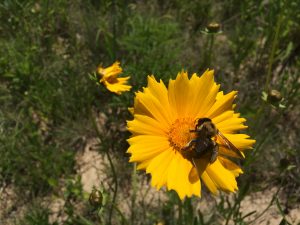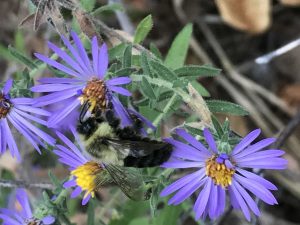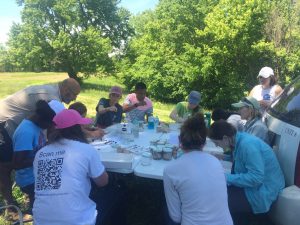The Vital Role of Bees in Pollination
By Michele Schutzenhofer, Associate Professor of Biology, McKendree University and Gerardo Camilo, Professor of Biology, Saint Louis University.
Worldwide, many pollinators are in decline, which means that our food supply can be at risk. It is estimated that pollinators are responsible for approximately one-third of global crop production. While pollinators include highly charismatic groups like birds and butterflies, bees do the majority of the work. Amazingly, the best known pollinator, the introduced European honeybee, is responsible for between 10 and 30% of our crops. For many of the crops that require pollination, honeybees are not a good alternative. For example, tomatoes, a highly popular crop found in the nightshade family (Solanaceae), require so called ‘buzz pollination’, something that only bumblebees and large carpenter bee can do. The same is true for other crops in the same family like peppers, eggplants and potatoes. There are over 20,000 species of bees worldwide and we need to learn a lot more about them. Bees range in size from about an inch long (Carpenter bees) to 1/16th of an inch (fairy sweat bee). The vast majority of bees are solitary and not social. They tend to nest in the ground or in small cavities. Some species are highly specific in the use of plants visiting one or just a few species of flowers. The other extreme is the honeybee, which is a generalist, and has been documented as visiting over 3,000 different plant species. Thus, understanding the diversity and abundance of bees is tremendously important for managing and conserving pollinators. In Illinois, there are an estimated 500 species of bees, including one on the endangered species list, the rusty-patched bumblebee. How many and what kinds of bees are found in any given location is influenced by a large number of factors, but we understand some of the basics.

Eastern carpenter bee (Xylocopa virginica). Photo courtesy Mickey Schutzenhofer
Bees currently face a growing number of concerns, including habitat loss, increased agricultural intensification, emerging bee diseases, and pesticide use. The good news is that conservation and restoration of habitat, even in small areas, can greatly help bee communities persist despite these challenges. What we know about bees is that they are highly resilient to change if their essential needs are met. These needs include a diversity of flowers (nectar and pollen resources) throughout the growing season, diversity of soils for nesting (think sandy vs. clay), and a diversity of brush and bramble (for nesting needs as well). These resources once largely co-existed even with agriculture and land development. However, with expansion of large-scale monocultures, even the small little patches that once remained in roadsides and ditches, and those pesky ‘weeds’ in the middle of fields and lawns, are quickly disappearing. Thus, the protection of remnants and restoration of small patches of habitat are critical. If areas that once served as intense agricultural areas are restored, these locations can not only serve as a safe heaven, but also as sources for other populations. One recent local restoration is that of the approximately 280 acres of native prairie planted at the Paul Wightman Subterranean Nature Preserve in Fults.

Common bumblebee (Bombus impatiens) on New England Aster. Photo courtesy Joann Fricke
In the summer of 2017, researchers from McKendree University and Saint Louis University teamed up to evaluate if the bee community had found this new patch of habitat, and evaluate if the restoration was successful in providing habitat for a diversity of bee species. Their overarching goal is to compare and contrast the bee communities in the southern Mississippi bluff corridors, including the patches of rare remnant hill prairies. Students and faculty from both institutions sampled the prairie once a month from May until October. Using aerial nets (ie, butterfly nets), they collected over 1,000 bees from five of the six families of bees found in Illinois. Among the most common species was the common eastern bumblebee (Bombus impatiens), the brown belted bumblebee (B. grisceocolis), and the alfalfa leaf-cutter bee (Megachile rotundata). This last species, as the name suggests, is a very good pollinator of alfalfa.

Professor Gerardo Camilo, standing, left, and students from McKendree University and Saint Louis University gather to pin bee specimens after collection. Pinning is necessary so that specimens can be examined under a microscope for proper identification. If properly pinned and preserved, specimens can be available indefinitely for future studies. Photo courtesy Mickey Schutzenhofer.
CLIFFTOP, a local nonprofit organization, is focused on preserving and protecting area blufflands.
A version of this article appeared in the September 7, 2018 edition of the Monroe County Independent.
©2018 all content rights reserved Clifftop NFP
Comments are currently closed.
